67% of SMB marketers are struggling with app sprawl. Find out how to tackle it at your business.
Marketers rely on software or applications for just about everything—managing campaigns, analyzing data, and connecting with their target audiences. In fact, 67% of SMB marketers plan to invest more in tech in 2023.
While software has undoubtedly transformed the role of marketer, the sheer number of apps can lead to lower productivity, sunk time, and drained budgets. Additionally, navigating multiple apps is especially challenging for small to midsize businesses (SMBs) that may lack the IT resources to maintain them or integrate them with current systems.
What is app sprawl?
App sprawl, also known as software sprawl or SaaS sprawl (in the case of cloud-based apps), occurs when a company continuously adopts new technologies without removing old ones. App sprawl puts strain on IT teams and end users alike, resulting in redundancy, cybersecurity risks, and time and money lost to managing more applications than the company needs.
According to Capterra’s 2023 Marketing App Sprawl Survey, 67% of marketing or advertising SMB professionals say their company is impacted by app sprawl. Our respondents estimate that on average, only 62% of the applications at their company are being used regularly.*
The following research reveals how companies are investing in and using marketing applications and the problems that arise due to software redundancies. We’ll also give tips for combating app sprawl at your company.
/ Key findings
Redundant apps waste time and money: 39% of SMB marketers find that having redundant apps increases the time they spend on day-to-day tasks. They also estimate that their company is spending approximately $43,500 annually on software apps it does not use regularly.
Underused app features can create risk without return: A staggering 63% say that redundant apps either have no impact or even have decreased their company’s technology ROI.
Reducing app sprawl requires clear processes for adding or removing apps and follow-through: Only 26% of SMB marketers say that their company formally cancels service and/or payments with the software provider even after decisions to retire or remove apps have been made.
Too much technology?
Marketing teams need a variety of tech to meet their objectives and deliver results. So how many different software applications do they typically use?
A majority (93%) of SMB marketing teams say their company has between one to 20 software accounts in total. And for apps that are specifically used for marketing purposes, 87% of respondents say their company has between one and 10 apps. That’s a lot of tech to navigate.
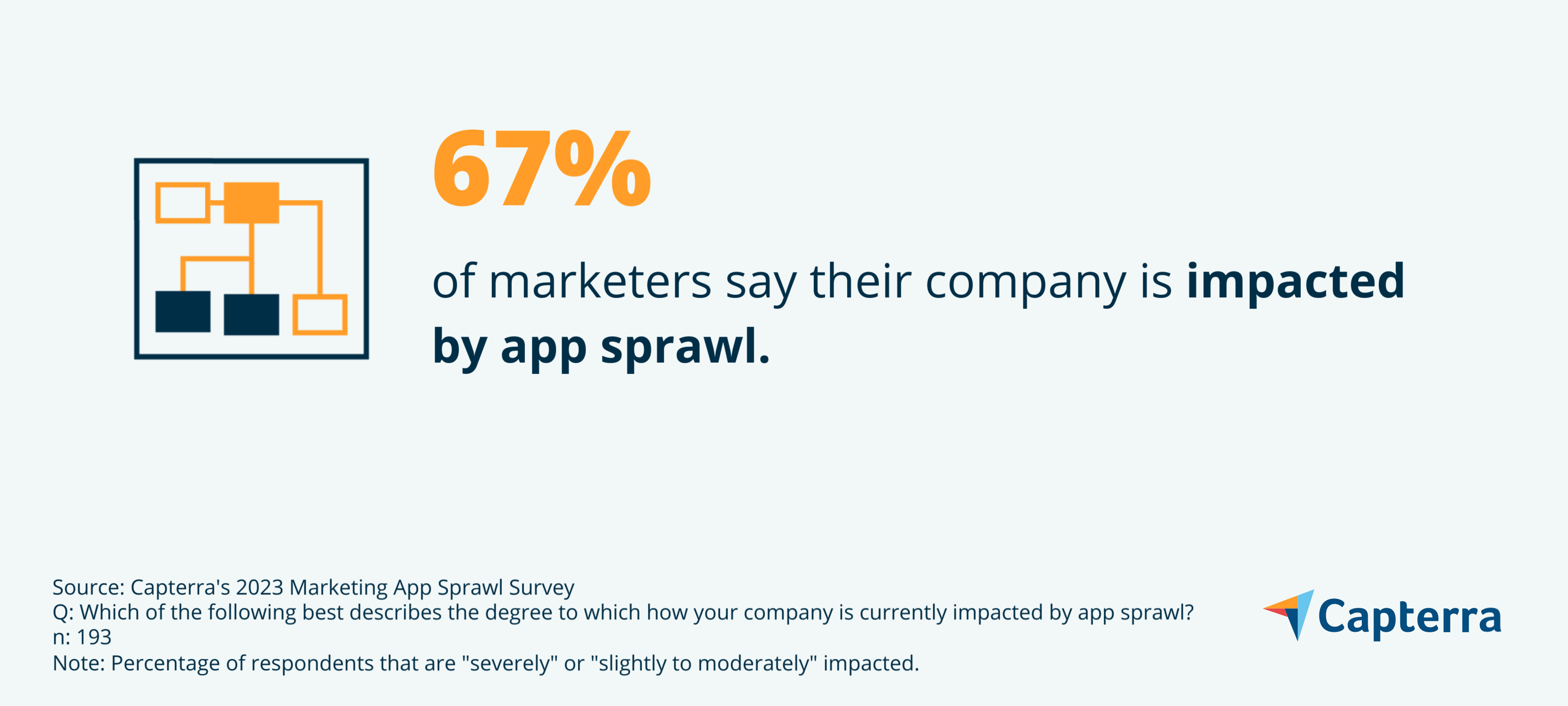
And with new hype around generative AI technology, we can expect even more apps to enter the scene. As noted in recent research from Capterra, 95% of marketers believe that AI technology will make their day-to-day job responsibilities better.
The unique app preferences among SMB marketers
Why do SMB companies keep adding new apps? The most common reason SMBs have redundant applications is to support employee preferences. Take email, for example. You might have one team that has a strong preference for Google versus another that is dead set on Outlook.
Surprisingly, employee preferences even outweigh concrete needs, which means that marketers themselves could be driving some of the app sprawl companies face.
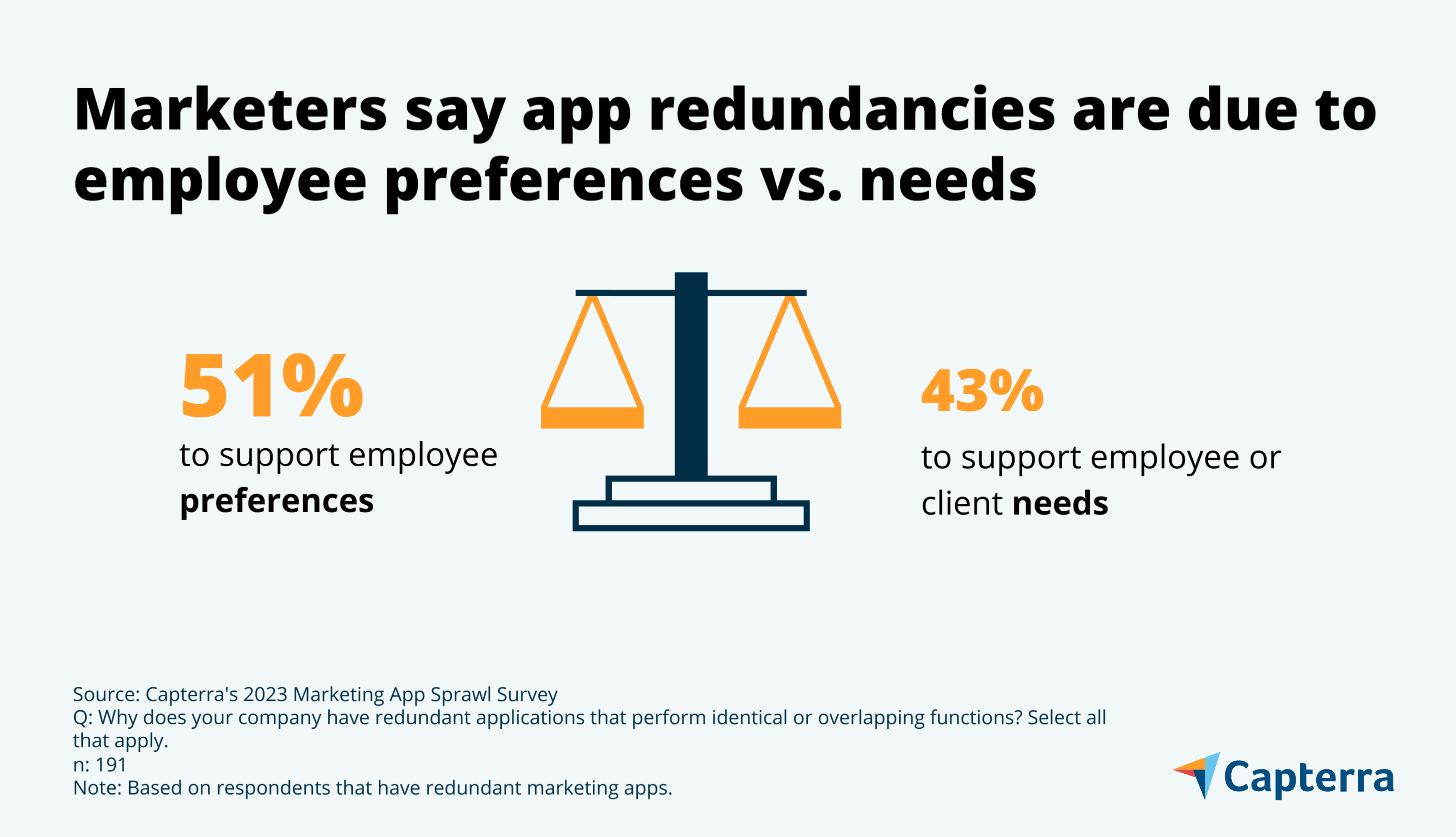
Other reasons contributing to redundancies are staying innovative (47%), being flexible in how they work (44%) and keeping up with competitors (39%). This makes sense for the fast-paced marketing industry where staying agile and competitive is key.
Let’s take a closer look at how SMB marketers are investing in new software to better understand the extent of the challenge.
How much are marketing teams spending on underused apps?
SMB marketers believe that a whopping 40% of marketing apps at their company are not being used regularly (meaning on a daily or weekly basis). And unfortunately, our research finds that there are a number of overlapping or unused features plaguing marketing app investments.
Marketers say that on average, more than half (51%) of the apps being used specifically for marketing purposes at their company are redundant (i.e., perform identical or overlapping functions).
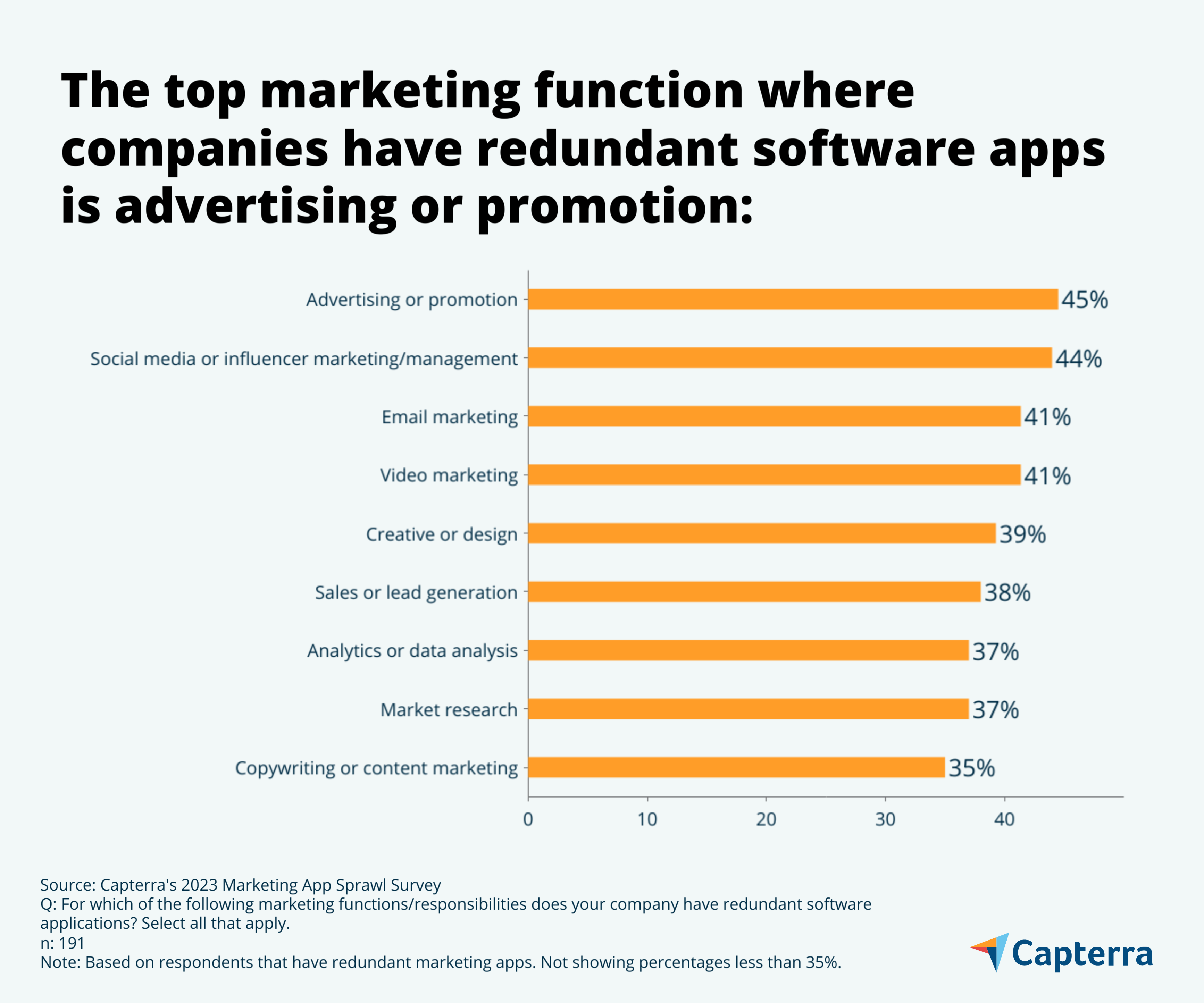
This also means unnecessary costs for SMBs. In fact, marketers in our survey estimate that their companies are spending approximately $43,500 annually on software apps they do not use regularly.
SMB marketers are overwhelmed with app sprawl challenges
App sprawl creates challenges for marketers, including lost time, too many unused features, and inconsistent levels of accessibility or use between apps. Below are the top challenges marketers identified in our survey, and tips for addressing them:
Sunk time on learning new tech (46%): With vast numbers of apps available for different purposes, marketers need to familiarize themselves with new features, capabilities, and interfaces for each one.
/ Pro tip
It doesn’t always come down to the tech—it's about the people and process involved. Instead of buying more apps, your company should invest in continuous tech training to set up marketing teams for success and allow more users to be equipped to use the software your company has already invested in. A good first step is to outline the top skills you need to develop on your team.
Time spent switching between apps adds to inefficiency (41%): A disjointed workflow can make it difficult to stay organized or even track activity between apps. A shocking 39% of marketers find that having redundant apps increases the time they spend on day-to-day tasks. In fact, rather than adding to productivity, 62% of marketers say that redundant marketing applications have no impact on their efficiency.
/ Pro tip
If using multiple apps is taking away from your daily productivity, it may be time for your company to consolidate workflows into one centralized app, look for apps that offer integrations with other tools, or reduce the number of applications in use. We’ll review how SMB marketers are integrating, consolidating, and sunsetting apps later on in this report.
Too many unused features (40%): Many apps have a wide range of features that marketers may not need, leading to cluttered or overlapping capabilities throughout a company. This can be confusing for marketers that aren’t sure which software they should be using for a particular task. Furthermore, having additional features doesn’t translate to increased technology ROI for most marketers—45% of respondents state that redundant apps have had no impact on technology ROI, while 19% say that it even decreases it.
/ Pro tip
To prevent feature overlap it’s important to establish a baseline of the tools at your company. Auditing provides a starting point to determine how your technology investments align with objectives. Some key questions to help you prepare include: What technologies is your marketing team using today? Who is using each tool and at what cost? What are the outcomes you expect the technology to deliver?
Inconsistent accessibility between apps (35%): Some apps may have different access credentials or user levels that might lead to frustration or wasted time trying to navigate for a busy marketer. Also, 27% of marketers say they don’t even know which apps are owned or used.
/ Pro tip
Work with your IT team to ensure consistent levels of accessibility and set expectations for martech usage. Your IT may also be able to implement app management tools that allow them to monitor app usage and ensure that new apps are evaluated before they are adopted at your company.
A game plan to prevent app sprawl
A majority (84%) of SMB marketers say that their companies are conducting regular software audits—and this percentage is even higher among those with formal IT departments (88%). However, 27% of SMB marketers say they still don’t know which apps are owned or used at their companies.
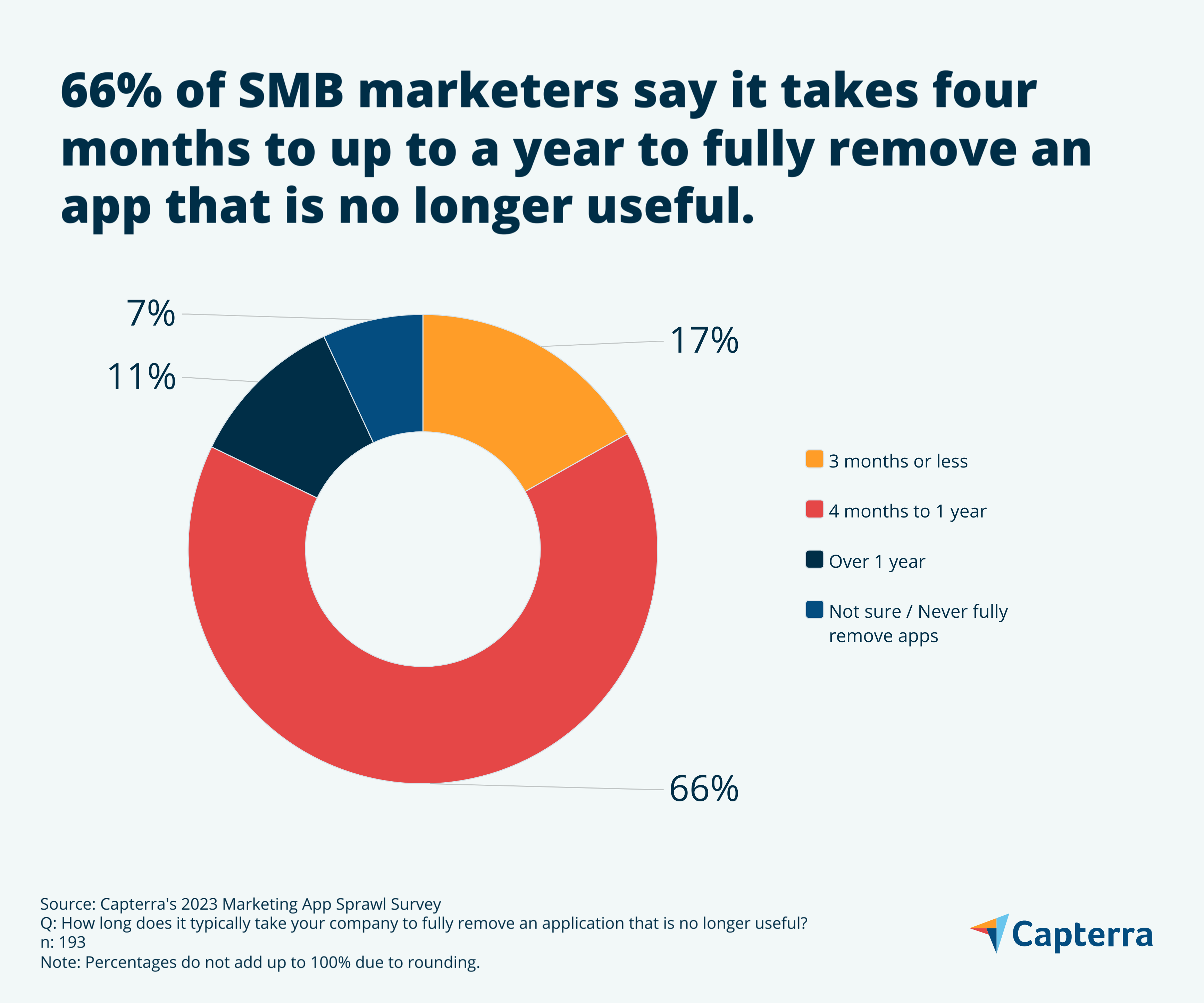
Furthermore, a third of SMB marketers state that their company doesn’t have plans to consolidate software applications or they aren’t sure if it does.
What is contributing to issues with adding new apps, removing them, or consolidating?
1. Too many employees can request apps.
Only 34% of SMB marketers are actively limiting non-IT employees' ability to adopt new software without approval. Additionally, 45% of SMB marketers say that any employee at their company can make requests to their IT department to add new apps.
2. Too many stakeholders are involved when removing apps.
50% of SMBs say they must consult with various business units in order to get rid of software that is no longer useful. Thirty-nine percent must also have internal stakeholders come to agreement on whether or not an app should be retired.
And even when decisions to retire apps are made, only 26% of SMB marketers say that their company formally cancels service and/or payments with the software provider. This points to an overall lack of strategy and follow through for retiring technology.
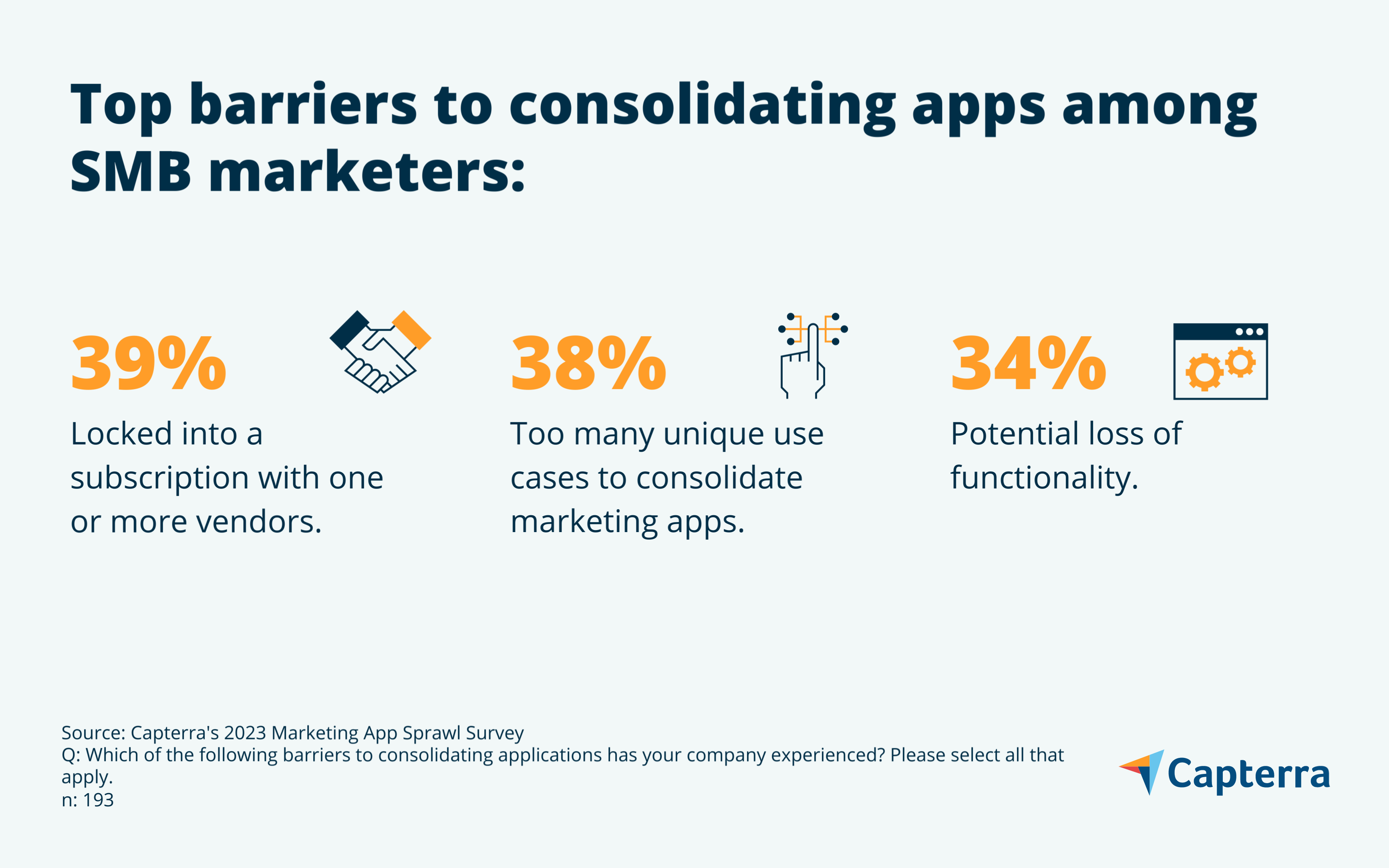
It is essential to stay on top of marketing app usage and evaluate which apps are actually needed for business operations, especially as emerging tech and innovation continues to entice marketers.
App sprawl can be addressed through tactics like:
Training: It's essential to invest in continuous technology training to help your marketing team make the best use of software your company has already invested in.
Consolidation: Multi-functional software suites are a great option for preventing app sprawl. Over a third (37%) of marketers say their company has replaced standalone applications with multi-functional software suites.
Integration: Even when adopting standalone apps, 29% of marketers prefer integrating them into current systems versus leaving them unintegrated (10%). To ensure different apps can work together, having an integration plan or timeline is key. Also, before making any future software purchase decisions, research your desired software’s integration capabilities or support to ensure you don’t end up with a siloed system.
Regular app audits: Conducting regular app audits can help your team get a holistic view of its technology adoption and usage. Try conducting an audit at least two times a year, if you aren’t already.
By reducing the number of apps in use and the number of stakeholders involved in app requests and removals, marketers can improve productivity, reduce unnecessary spending/costs, and make their day-to-day operations more streamlined.
Interested in learning more about what technology SMB marketers are prioritizing in 2023? Check out Capterra’s 2023 State of Marketing Software Adoption Report.

